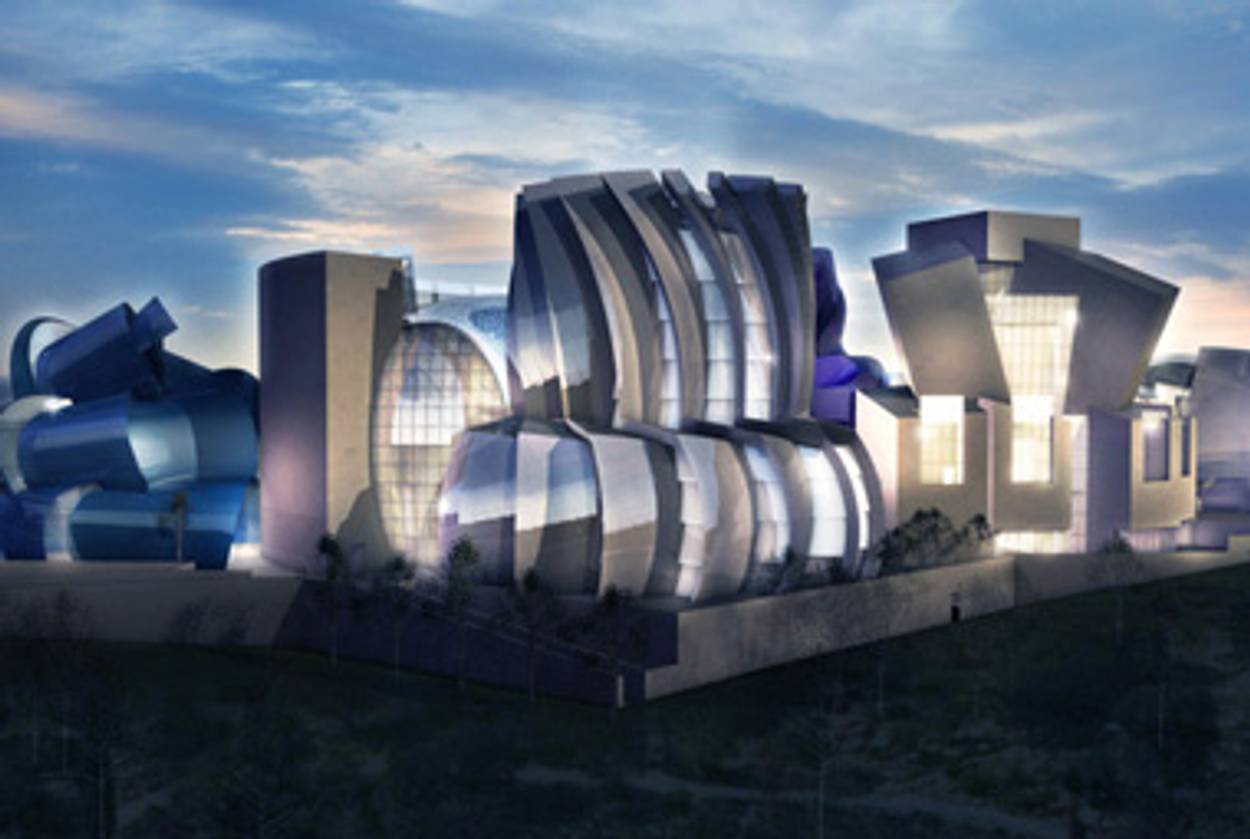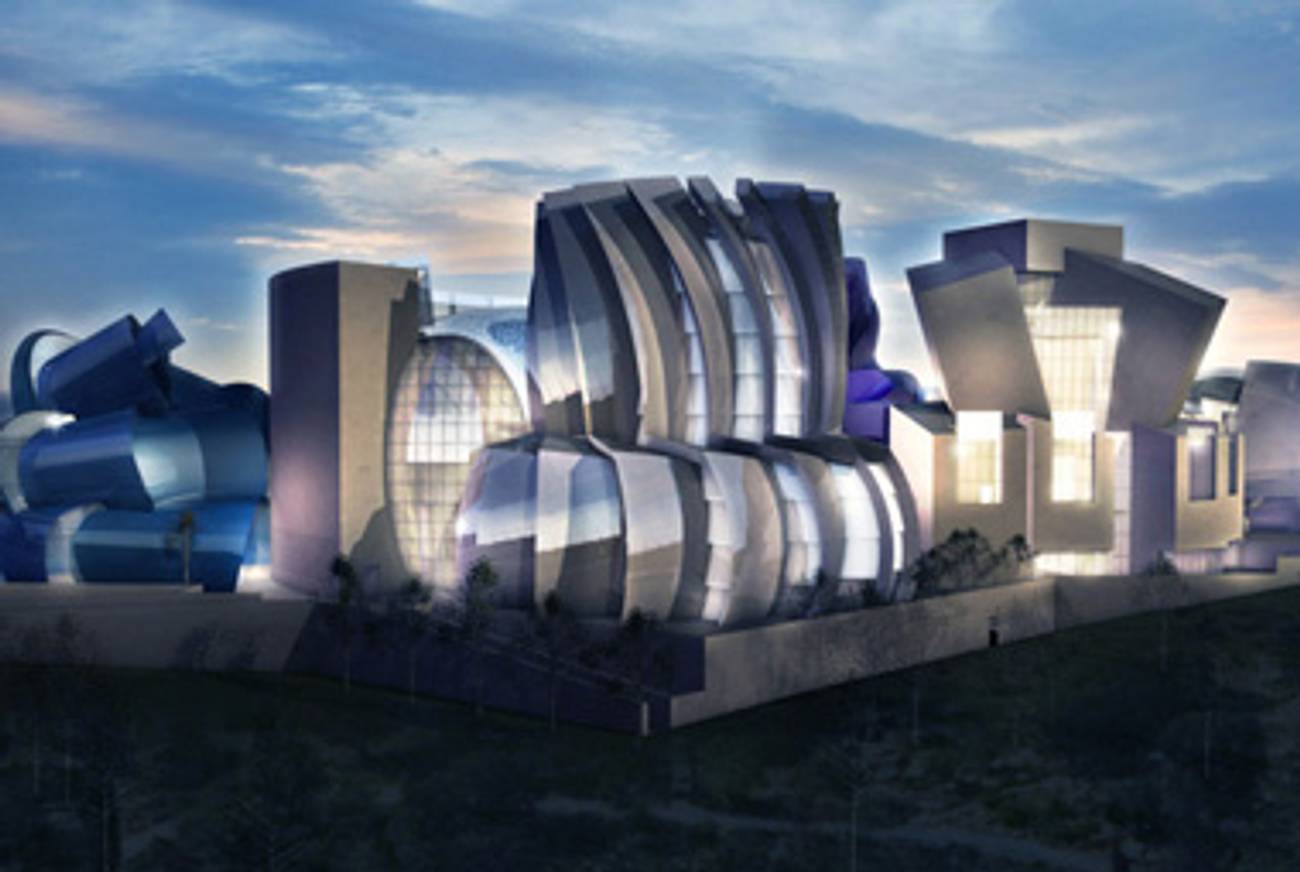Unbuilt
Architect Frank Gehry withdraws from plan to build Museum of Tolerance in Jerusalem




After years of protests and an unsuccessful legal challenge, architect Frank Gehry has pulled out of a project to build a Jerusalem counterpart to the Simon Wiesenthal Center’s Museum of Tolerance that is slated to stand on a site that was once part of an ancient Muslim cemetery.
“We are no longer involved in it,” said Craig Webb, the design partner in charge of the project for the firm of Gehry Partners. He said the Simon Wiesenthal Center, which opened its original Museum of Tolerance in Los Angeles in 1993, no longer had the right to use Gehry’s design and was considering alternatives. The center’s website currently reads “please check back soon” under a page devoted to the Jerusalem initiative. As the blogger Philip Weiss noted last week, all references to Gehry and images of the $250 million project have been removed from the site.
Gehry’s withdrawal is but the latest in a series of obstacles to have come in the project’s way. Sheikh Raed Salah, a leader of Israel’s Islamic Movement, has charged that the construction would desecrate an Islamic holy site and, together with Jerusalem Arab families whose ancestors are buried in the Mamilla Cemetery, he petitioned the Israeli Supreme Court to block it.
But in November 2008, the high court gave the go-ahead for construction, arguing that no objections were raised in 1960 when a parking lot was placed over a small part of the cemetery, which was in continuous use since at least the 13th century up to the early 20th. Jerusalem Mayor Nir Barkat has given the project his full support—“I don’t see any problem with the site, it’s a non-issue,” he said in an interview last August—and municipal authorities have awarded the project all the necessary construction permits.
Israeli scholars, cultural figures, Orthodox leaders including Knesset member Rabbi Meir Porush, and American rabbis have joined in vehemently opposing the museum, along with a group of leading British architects who signed a petition condemning the proposed museum as a “blow to peaceful co-existence” in the city. Jerusalem’s former deputy mayor, Meron Benvenisti, has denounced it as “so hallucinatory, so irrelevant, so foreign, so megalomaniac.”
The Central Conference of American Rabbis, an umbrella group representing some 1,500 Reform rabbis, has urged the Wiesenthal Center to find an alternative location to the three-acre site in downtown Western Jerusalem. “There is something profoundly disturbing about the idea of putting a Jewish Museum of Tolerance on a plot of land where Muslims have been burying their dead for most of the last 800 years,” wrote Rabbi Eric Yoffie, president of the Union for Reform Judaism.
Shimon Shamir, a former Israeli ambassador to Egypt and Jordan who now heads the Institute for Diplomacy and Regional Cooperation at Tel Aviv University, said he met with Gehry in Los Angeles two years ago in a bid to persuade him to withdraw. “I explained what a big mistake it was,” Shamir said by phone from Tel Aviv. “I hope it will never be built.”
Webb, Gehry’s partner, would not say why his Los Angeles-based firm ended its involvement, saying only, “it is politically very sensitive.” Gehry himself was not available for comment, nor was Rabbi Marvin Hier, founder and dean of the Simon Wiesenthal Center.
The grandiose design, which was to be crafted from a gaudy, futuristic mix of titanium, glass and stone, would hardly have ranked among Gehry’s finest creations. Along with Santiago Calatrava’s lyre-shaped light railway bridge completed in May 2008, the Gehry scheme sparked furor among those who charge that it injects inappropriate architectural elements into Jerusalem’s stone-faced, historic cityscape. Esther Zandberg, architecture critic for Ha’aretz, called it an “unnecessary and irreversible eyesore.”
Hier has long championed the project, saying that the only part of the graveyard that would be used for the museum has already been turned into a parking lot. The Wiesenthal Center further argued that in the 1920s Muslim authorities in Jerusalem authorized the removal of bones from the same cemetery to allow the construction of the Palace Hotel. But this claim has been disputed by the former rector of Hebrew University, Yehoshua Ben-Arieh, a leading expert on Jerusalem’s geographical history.
In addition to the uproar about both the design and the site, many Israelis have questioned whether the Wiesenthal Center could effectively transfer to the Israeli-Palestinian conflict the sort of exhibitions and diversity training operations that it currently runs at the Museum of Tolerance in Los Angeles and a separate New York Tolerance Center.
A lavish groundbreaking ceremony was held in 2004 where Gehry, who was originally named Goldberg but changed his name in adulthood, was joined by Benjamin Netanyahu and Arnold Schwarzenegger. Citing the “darkness that pervades the Middle East,” Schwarzenegger predicted that “this building will be a candle to guide us.”
Gehry, the architect of the Guggenheim in Bilbao and the Walt Disney Concert Hall in Los Angeles, told The New York Times soon afterward that the Jerusalem project awakened memories of his Jewish upbringing.
But controversy flared two years later when bones were uncovered at the site. Today, construction hoardings surround a quiet plot.
Michael Z. Wise is a contributing editor at Travel + Leisure magazine and has written on cultural topics for The New York Times, The Washington Post, the Los Angeles Times and ARTnews.
Michael Z. Wise, the author of Capital Dilemma: Germany’s Search for a New Architecture of Democracy, is a contributing editor at Travel + Leisure.
Michael Z. Wise, the author of Capital Dilemma: Germany’s Search for a New Architecture of Democracy, is a contributing editor at Travel + Leisure.